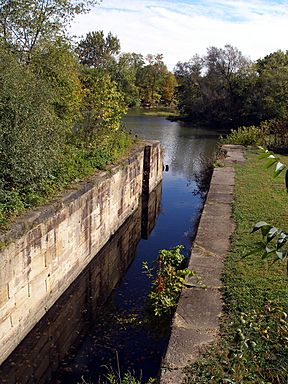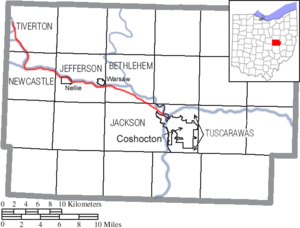Walhonding Canal facts for kids
Quick facts for kids Walhonding Canal |
|
|---|---|

View of the bottom of the "Triple Locks", a series of three locks where the Walhonding Canal emptied into Roscoe Basin and met the Ohio and Erie Canal in Roscoe Village, Ohio.
|
|
| Specifications | |
| Length | 25 km (16 miles) |
| Minimum boat draft | 4 ft (1.2 m) |
| Locks | 13 |
| History | |
| Date of act | 1836 |
| Date closed | 1896 (abandoned) |
The Walhonding Canal was a special waterway, called a canal, in Coshocton County, Ohio. It helped carry water and boats to a bigger canal called the Ohio and Erie Canal. This canal was quite small, only about 25 miles (40 km) long. It stayed completely within Coshocton County. It followed the Mohican River from a place called Cavallo, heading south. It went to where the Mohican River met the Kokosing River. These two rivers then formed the Walhonding River. The canal then followed the Walhonding River southeast towards Coshocton. There, it connected with the Ohio and Erie Canal in Roscoe Village.
Contents
Building the Canal
Work on the Walhonding Canal started in 1836 and finished in 1842. Many engineers and workers helped build this important waterway. Some of the key engineers included William H. Price and Sylvester Medbery. These people also worked on the larger Ohio and Erie Canal.
The canal cost a lot of money to build. It cost over $607,000, which was a huge amount back then! This meant it cost about $24,000 for every mile of the canal.
First Boats and Leaders
The people in charge of the Walhonding Canal were called Superintendents. Some of them were Langdon Hogle and John Perry. The very first canal boat launched in Coshocton County was named the "Renfrew." It was named after James Renfrew, a merchant from Coshocton. A man named Thomas Butler Lewis, who was an experienced boatman, built this first boat.
Plans for Expansion
There were plans to make the Walhonding Canal even longer. People wanted to extend it to the northwestern part of Ohio. However, by 1842, new and faster ways to travel, like railroads, were becoming popular. Building canals was also very expensive. Because of this, lawmakers from areas that didn't need canals anymore didn't want to spend money on extensions.
Proposed Routes
Two years after the canal was first approved, officials tried to get permission for extensions. One idea was to add 23 miles (37 km) north along the Mohican River. Another idea was to add 21 miles (34 km) west along the Kokosing River towards Mount Vernon. By 1844, it was clear that these extensions would not be approved. So, the requests for money to build them stopped.
The Ohio General Assembly had first approved these extensions in 1838. The extension to Mount Vernon depended on another company giving up its rights. This was to make sure the state of Ohio could build the canal without problems. The extensions also needed to be carefully surveyed and approved before construction could start.
Why the Canal Closed
The state officially stopped using the Walhonding Canal in 1896. It was no longer needed for transportation. A railroad then took its place, following the same path. This railroad operated until 1936. That's when the Mohawk Dam was built to help control floods. The dam effectively blocked the railroad's path, ending its use as well.
Images for kids




